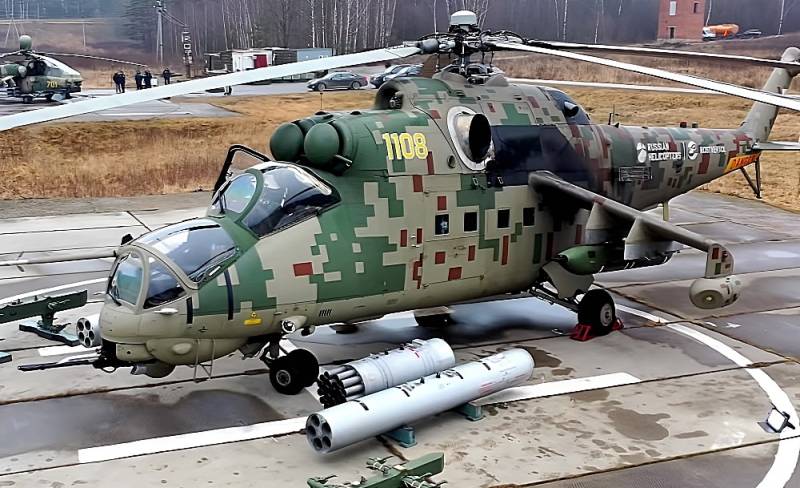Can the Mi-35M become the first air drone carrier?
The main obstacle to the counter-offensive of the Armed Forces of Ukraine, in addition to minefields and fortification lines, was the Russian army and front-line aviation. Attack aircraft and bombers attack from a safe rear without entering the enemy's air defense coverage area. Attack helicopters risk the most when operating at ultra-low altitudes, but show the most impressive results, destroying quite modern armored vehicles, including Western-made ones. But how long will our air superiority last?
This question is far from idle. It is extremely likely that as a result of the counteroffensive, instead of signing Minsk-3, Kyiv will receive A-10 Thunderbolt II attack aircraft, fourth-generation F-16 fighters and Apache attack helicopters. After that, the picture on the battlefield, unfortunately, will seriously change, and not in our favor. Our own attack helicopters, being targeted by American air-to-air missiles, will no longer be able to dominate the air, and the enemy will begin to support ground attacks of their armored vehicles. In the long run, all this can create serious problems. In this publication, I would like to talk about the possibility of increasing the efficiency of domestic army aviation by developing previous ideas rearmament of attack helicopters.
"Flying BMP"
If you look at the reports of the Ministry of Defense of the Russian Federation, it is obvious that the Ka-52 and Mi-28NM helicopters play the first fiddle there, heroically destroying enemy armored vehicles under retaliatory strikes from air defense systems and MANPADS. At the same time, the survivability potential of the Alligator was revealed, which was able to return to the base with the keel torn off as a result of shelling. Any other helicopter of conventional design could hardly repeat the feat of the Ka-52 crew. However, I would like to focus on another aspect.
The fact is that the Soviet and NATO concepts for the use of attack helicopters initially followed different paths. The potential enemy expected to stop our tank wedges with the help of many light two-seat helicopters carrying from 4 to 6 air-based ATGMs. In the USSR, they relied on a heavy attack well-protected helicopter, at the same time capable of carrying troops. It was assumed that such a “flying infantry fighting vehicle” would destroy the enemy’s infrastructure from the air with unguided weapons, finishing off his firing points and manpower from airborne guns and machine guns. Then, in the near rear, it was possible to land troops from helicopters.
This is how the Mi-24 appeared, unofficially called the "Crocodile". In terms of the number of cars produced, it is in second place in the world after the American Apache, these are 3500 units. On the basis of the export version of the Mi-24 (Mi-35) helicopter, a modernized Mi-35M was created. This rotorcraft managed to take part in many armed conflicts around the world and showed itself well. However, it was experimentally revealed that for maximum effectiveness in combat use, great specialization is required: either to be shock or landing. As a landing helicopter, military versions of the Mi-8 are better suited, in particular the Mi-8AMTSh-VN, which is positioned as a "flying airborne combat vehicle." How the shock Mi-24 with its compartment for eight paratroopers turned out to be too large and bulky.
In the end, everything fell into place. Enemy armored vehicles are now being hit by Ka-52 and Mi-28NM attack helicopters. But during the operation of the Airborne Forces near Gostomel, the main load fell on the Mi-8, supported by the Ka-52, Mi-28N and Mi-35.
Does this mean that the very concept of "Crocodile" was erroneous and now nothing can be done about it?
Return of the legend
Like us noted earlier, talking about the prospects for unmanned helicopters, the main problem of army aviation is the need to operate at ultra-low altitudes within the reach of enemy air defense systems and even MANPADS. This is primarily due to the relatively short range of air-launched anti-tank missiles, which can effectively hit targets at a distance of 6 to 10 km.
For your information: the maximum range of destruction for the American-made Stinger MANPADS reaches 4500 m, and for the Buk air defense system - up to 70 km. This is a very serious threat to Russian attack helicopters. However, the alignment can be quite easily and simply changed in our favor by re-equipping or re-equipping rotorcraft.
Thus, it seems to be a very promising direction to introduce kamikaze drones of the Lancet and even the Cube type into the range of armaments of our army aviation, equipping helicopters with an air launch system. The flight range of "Cuba" reaches 10 km, but for "Lancet-3" it is from 40 to 70 km! With a warhead weight of 5 kg, with the help of loitering ammunition, you can burn any enemy armored vehicles, remaining outside or on the very edge of the range of its medium-range air defense systems of the Buk type and completely out of reach of MANPADS.
The Ka-52, Mi-28NM, and Mi-8AMTSh-VN can be equipped with Lancets, but the obsolete Crocodile seems to be an almost ideal platform for creating an airborne drone carrier. This helicopter is initially well armored and protected, and in its troop compartment it is possible to place a control point for loitering ammunition with operators. The suspension will freely accommodate a dozen "Lancets" and even several "Cubes", which are a kind of budget high-precision weapons.
The Mi-24 and Mi-35M re-equipped with kamikaze drones can become highly mobile aerial firing points that can hit targets at a distance of 40 to 70 km. In one sortie, each helicopter is able to destroy several enemy armored vehicles, remaining outside the zone of its air defense and receiving target designation data from a reconnaissance drone. Operators from a protected air point will be able to target the loitering ammunition.

Information